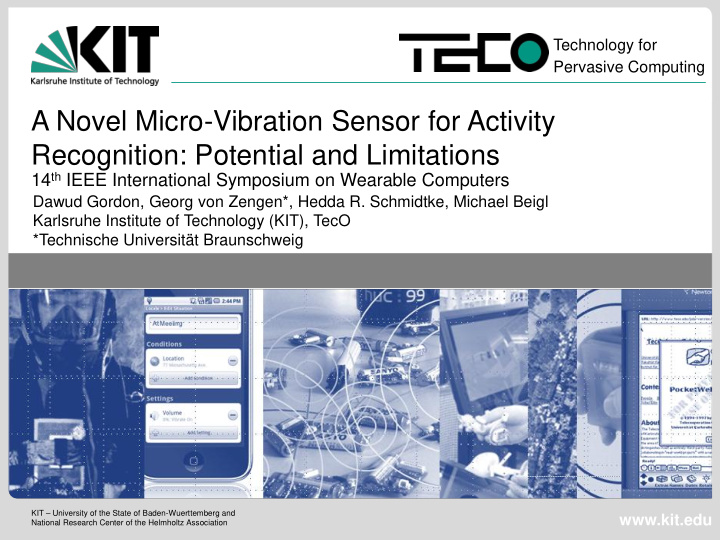



Technology for Pervasive Computing A Novel Micro-Vibration Sensor for Activity Recognition: Potential and Limitations 14 th IEEE International Symposium on Wearable Computers Dawud Gordon, Georg von Zengen*, Hedda R. Schmidtke, Michael Beigl Karlsruhe Institute of Technology (KIT), TecO *Technische Universität Braunschweig KIT – University of the State of Baden-Wuerttemberg and www.kit.edu National Research Center of the Helmholtz Association
Sensor Modalities on Mobile Phones Acceleration 9 Light Proximity Touch Camera GPS 4 Rotation Temperature 2 Compass 1 Microphone 0 2000 2002 2004 2007 2010 How does the community know which sensor is next best thing, and how to use it? Dawud Gordon Technology for 2 08.06.2012 Pervasive Computing
A Novel Sensor Recent advances in production techniques improve sensitivity Sensolute GmbH www.sensolute.com Devices have become sensitive and stabile Asks the question, what can we do with this that we couldn’t before? How does it compare with an acceleration sensor for activity recognition? Dawud Gordon Technology for 3 08.06.2012 Pervasive Computing
Ball Switch Research “ The MediaCup: Awareness Technology embedded in an Everyday Object ” Gellersen, Beigl, Krull, 1999 “ Spine versus porcupine: a study in distributed wearable activity recognition ” Van Laerhoven, Gellersen, 2004 “ Using rhythm awareness in long- term activity recognition” Van Laerhoven, Killian, Schiele, 2008 Dawud Gordon Technology for 4 08.06.2012 Pervasive Computing
Micro-vibration sensor MVS 0608.02 2.45 x 2.85 x 1.7 mm Ball diameter of 0.8 mm Opens and closes a circuit Hermetically sealed chamber SMD – automatically mountable and solderable Cost: 1.75 USD Dawud Gordon Technology for 5 08.06.2012 Pervasive Computing
The Data stream Digital output signal from MVS Interesting units are the unary signal transitions: “ events ” Events summed over short windows to produce the amplitude of a cumulative wave This signal “comparable” to analog sensor output Sample windows can now be generated using a sliding or overlapping window Dawud Gordon Technology for 6 08.06.2012 Pervasive Computing
Vibration Analysis 50 Hz to 10 kHz 1 V to 5 V Dawud Gordon Technology for 7 08.06.2012 Pervasive Computing
Vibration Analysis Results 3000 0.49 mm 2500 1.29 mm Avg. MVS Events (Hz) 1.92 mm 2000 2.38 mm 1500 3.19 mm 1000 500 0 50 250 500 750 1000 1250 1500 1750 2000 3000 4000 5000 6000 7000 8000 9000 10000 Vibration Frequency (Hz) Constant forced vibration vs impulse Dawud Gordon Technology for 8 08.06.2012 Pervasive Computing
Vibration vs. Acceleration sensor Micro-vibration sensor ADXL335 accel. Sensor 1.75 USD 5.50 USD 2.45 mm x 2.85 mm 4 mm x 4 mm 1 resistor 4 capacitors 1.5 kHz – 8kHz .5 Hz – 1.6 kHz 42 µW* @ 3 V 2 mW @ 3 V Technology for 9 08.06.2012 Dawud Gordon Pervasive Computing
Activity Recognition: Case Study 5 Subjects 8 Activities 60 Hz sampling Vibration Acceleration Light Temperature 142 Minutes of data All parameters in paper Dataset available at: http://www.teco.edu/~ gordon/MVS/ Prof. Dr.-Ing. Michael Beigl Technology for 10 08.06.2012 Pervasive Computing
Classification 3 classification phases Phase 1: Personalized classification, all subjects, 80%-20% Phase 2: Generalized classification, 4 vs. 1 Phase 3: Post-hoc sensing, light temperature acceleration, + MVS Classification using WEKA toolkit and three popular classifiers K-Nearest-Neighbors Naïve Bayes C4.5 Decision Tree Dawud Gordon Technology for 11 08.06.2012 Pervasive Computing
3-Phase Results ADXL outperformed the MVS Recognition drop from personalized to generalized 29.4% for the MVS 56.6% for ADXL 4% increase when adding the MVS Dawud Gordon Technology for 12 08.06.2012 Pervasive Computing
Acceleration Results in Detail Personalized classification, C4.5 Decision Tree Overall 95.6% accuracy Standing and riding elevator Riding bus and riding elevator Generally good results Dawud Gordon Technology for 13 08.06.2012 Pervasive Computing
MVS Results in Detail Personalized classification, C4.5 Decision Tree Activities which consist of impacts (footfalls, bumps, etc.) are better recognized due to their high frequency components Activities with slow or rounded movements have worse recognition rates The “Typing” anomaly: high classification rate with many false positives Does not indicate that “typing” is easy to recognize System minimizes error by classifying all sample windows with very little or no activity as typing Dawud Gordon Technology for 14 08.06.2012 Pervasive Computing
Conclusions The MVS can be used to sense concussions high-frequency vibrations Low cost in terms of size, consumption and price Can increase recognition rates in wearable systems But, it will not replace the acceleration sensor Dawud Gordon Technology for 15 08.06.2012 Pervasive Computing
That’s All Thank You! Questions? Dawud Gordon Technology for 16 08.06.2012 Pervasive Computing
Recommend
More recommend